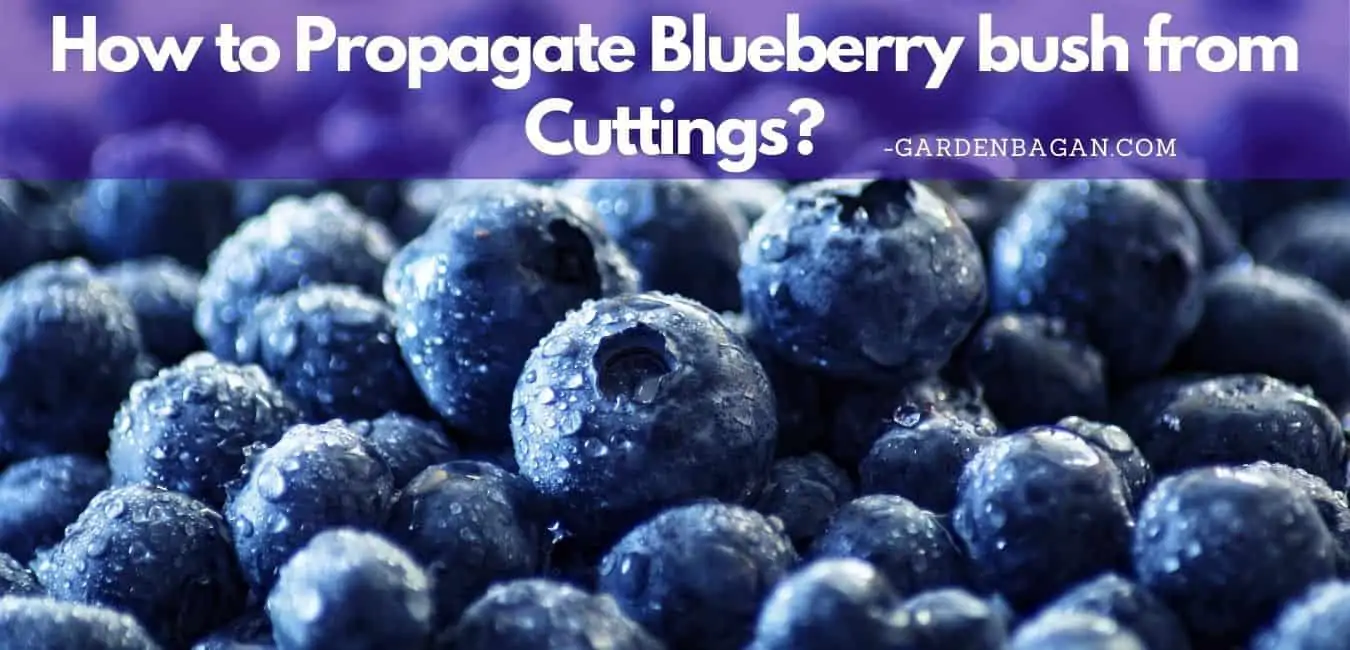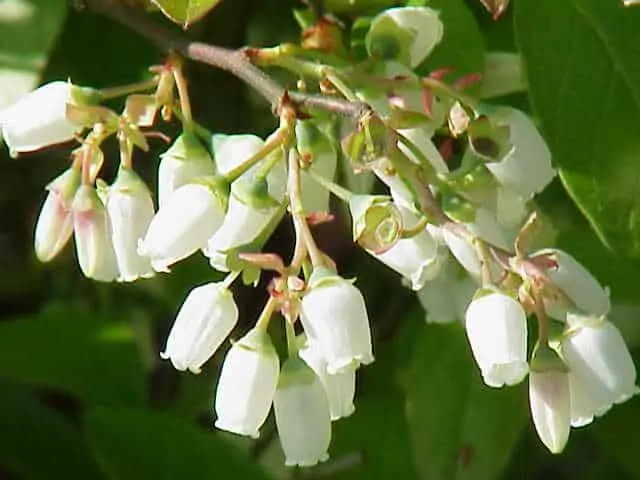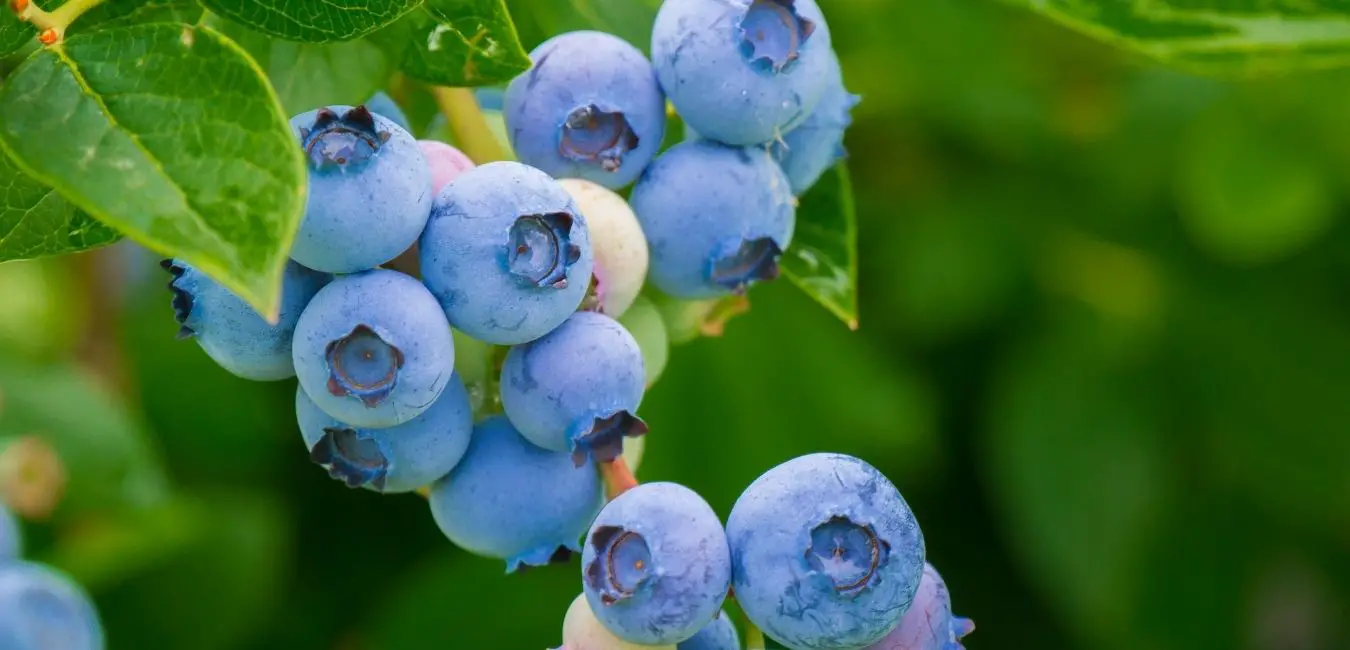Blueberries are perennial Flowering Plants. These shrubs produce tangy-sweet blue to purple-colored berries. It is a native North American Plant. You can easily grow Blueberries in USDA Zone 6 and Above. You should be careful with a blueberry plant in too cold and extremely hot areas.
We can use its seed as well as its cuttings to grow a Blueberry Bush. The plants grown from cuttings are preferred for Commercial farming. These cutting can quickly mature into a blueberry plant.
Plants developed from seeds have a slow growth rate. They can take 20-30% extra time to mature and bloom.

| Common Name: | Blueberry |
| Scientific Name: | Vaccinium corymbosum |
| Family: | Ericaceae |
| Native Country: | North America. Now commercially grown in Asia, America, Europe, and Australia. |
| Plant Type: | Perennial Hardwood Shrub.
Mostly evergreen can be deciduous as per location and variety. |
| Leaves: | 3-8 cm long and 0.5-3 cm broad.
Ovate to lanceolate in shape. Mostly light to Dark Green in color. |
| Flowers: | 8-10 flowers in a single bud cluster.
Bell Shaped White flowers. Pale Light pink, green and red flowers are common with blueberry varieties. |
| Fruits: | 5-8 berry in a single cluster. Small berries are light green. Then they mature and turn reddish-purple. Finally, the ripe blueberry becomes uniform blue.
10-18mm in diameter and approx. 0.3 grams in weight. The taste may vary from sweet to citrusy and tangy depending upon the variety and environment. Each fruit contains 100s of small seeds. |
| Plant Size: | Small dwarf varieties are 1-8 feet tall.
Tall varieties are 3-12 feet (approx. 4 meters) tall. |
Check out my previous post: How to Propagate a Lime or Lemon Tree by Air Layering?
Introducing Blueberry Bush
Some varieties of blueberry are wild others are native to our garden. Most of them have commercial and culinary use. Although their shape and sizes differ so as their taste. Their sweet and tangy sour flavor is a popular delight.
The blueberry plant can range from 1 to 12 feet. These plants are hardy and perennial in their surrounding. Some varieties can even survive in the cold Canadian climates.
Their leaves are 1-8 cm long and 1-3 cm broad. The blueberry bush is mostly evergreen with ovate leaves but sometimes it can be deciduous with lanceolate leaves. This variation is seen in different varieties grown in different locations.
The bell-shaped blueberry flowers are white, pink, red, or greenish in color. Out of 10-12 flowers in each bud set only 5-8 flowers fertilize and develop into a fruit.
The blueberry fruit starts as a small greenish fruit and turns reddish-blue to complete blue when ripe. These fruits are very sweet and full of juice. Blueberry is a small round fruit with a crown tip. Each fruit weighs almost 0.03grams.
A single blueberry contains 100s of tiny seeds. You can collect and regrow these sees into a new blueberry bush. Although you may have to wait for several seasons before it can bloom. Also, the fruits developed like this may differ from the actual fruit from which the seeds are collected.
Is Blueberry bush Easy to grow?
Yes, definitely blueberry bush is one of the easiest plants to grow anywhere in North America. It is a hardwood perennial shrub that can fairly tolerate mild frost.
If the soil, moisture, and nutrients are available abundantly then it is quite easy to grow a blueberry plant.
Can You Grow Blueberries in your backyard?
Yes, You can grow Blueberries in your Backyard. You just need to make sure the soil is acidic and well-nourished. It should be soft and contain enough moisture for root growth.
A garden fertilized organically is ideal for growing blueberries. If you are not sure about the soil type then mix some organic compost in it. Next, try planting a baby blueberry in a bright spot in your backyard.

This file is licensed under the Creative Commons Attribution-Share Alike 3.0 Unported license.
Where do Blueberries grow best?
Blueberries grow best in acidic soil with 4.2-5.2Ph. Though they can survive in Soil with an acidity lower than 6.5Ph.
USDA zone 6 and above is good to grow Blueberries. It can fairly tolerate mild frost. A mature old plant won’t die even in heavy snowfall. It will sprout new branches in the spring and grow again.
38 States in North America Grow Blueberry for Commercial use. 10 out of these 38 states are the major producers of Blueberries. They collectively grow 98% of total cultivation. These states are- California, Florida, Georgia, Indiana, Michigan, Mississippi, New Jersey, North Carolina, Oregon, and Washington.
Can You Grow Blueberries from cuttings?
A Blueberry plant can be easily grown from its cutting. Different varieties of blueberry have different branch sizes. Therefore it is a matter of choice to choose a specific variety.
Most of these varieties have slightly hardwood stems. You can choose any stem for cutting. But it is always better to choose a branch without any flowers or fruit. Also, a Semi-hardwood branch develops root faster than an old mature hardwood branch.
How to Grow Blueberry bushes from Cuttings?
You have to follow only 5 simple steps to grow a blueberry bush from its cuttings.
- Take a healthy soft cutting from a mature paren blueberry plant. Use a sharp clean knife for cutting the branch.
- Remove extra leaves from the bottom end. Also, remove any bud or flower if it has. Then dip the lower end of the stem in a rooting hormone powder.
- Put the cuttings in a healthy well-nourished growing media. Soft organic soil or potting mix will do the job.
- Cover the cutting and the entire Soil mix with a transparent plastic sheet. It should make a miniature greenhouse and prevent evaporation.
- Wait for 4-6 weeks for the roots to develop. Meanwhile, keep the soil mix moist and open the cover once every 4-5 days. Take out each cutting carefully after 6-8 weeks. Transplant it directly to a container of the garden.
| Name: | Blueberry |
| Soil Type: | Acidic Soil rich in organic matter is best for a blueberry bush.
Soft well-drained soil is required to grow blueberry bush. |
| Soil Ph: | The soil must have low 4.2-5.2 Ph. It can survive in soil with a Ph lower than 6.5 Ph. |
| Temperature: | Low to Moderate Temperature is required. |
| Sunlight: | 4-6 hours of direct sunlight is good for the blueberry bush. |
| Moisture requirements: | Moderate watering is recommended for the blueberry bush. |
| Fertilization: | Organic Kitchen waste or cow dung compost is very healthy for a blueberry bush
You can use NPK fertilizer high in potassium and Phosphorus for better fruiting. |
| Season: | Early spring to mid-summer is the best time to grow a blueberry bush. |
| Rooting Time: | 4-6 weeks is enough for rooting a blueberry cutting. Wait for at least 7 or 8 weeks for transplanting the new blueberry plants. |
Preparing Soil and Growing Media
Blueberry bush needs acidic soil rich in nutrition. This soil mix must have good drainage. You can easily grow a blueberry bush even in a container with a proper soil mix.
- Use 60% cocopeat with 10% soil and 30% compost for rooting the blueberry Cutting. Light cocopeat and soil mix will encourage fast root growth. The Compost will slowly feed the new plant until we transplant it.
- Make a final soil mix for transplanting your new blueberry plant.
- Use 30-40% Compost, 20% cocopeat, and 10% sand, and the rest 30-40% clean garden soil. Add 1 spoon full of contact fungicide in this soil mix.
- Finally, mix everything with half spoon of Epsom salt and 2 teaspoons of a balanced NPK 19:19:19. It will give a quick boost to your blueberry plants.

You should read: How to make potting soil for indoor plants?
Blueberry Parent Plant and Branch Selection
The selection of a Healthy and suitable parent blueberry plant is a very essential task. There are many commercial varieties of blueberry available in the market. It is a popular fruit so there are lots of hybrid variants available.
Above all, you must rely on the plants you can find nearby. Especially because the cutting can quickly lose moisture and droop. So You must find and mark out the parent plant before taking a cut.
One important consideration must be the plant size and fruiting time. Different varieties of blueberry have different plant sizes. Soe is small while others are as big as a tree. So make you have enough space in your garden or backyard to accommodate them.
A dwarf variety is ideal for container gardening but it will yield much less than tall varieties.
Now after selecting a parent plant you have to select a healthy branch. A blueberry bush will start sprouting new branches in early spring. These new branches are soft and very healthy. These are the ideal selection for rooting. You can choose the hard mature branch but it may take twice the time as compared to a softwood branch.
The softwood stem or branches will start drooping just after you cut them off. So make sure to put them in growing media or soil mix as soon as you can.
Precautions
- The Cutting should be softwood and free from any disease.
- The Knife should be sharp and clean. A blunt knife and damages the cut area. Also, a dirty or rusted knife can cause infection to bot parent and baby plant. Clean and sanitize the knife with rubbing alcohol.
- Proper coverage is essential to avoid excessive water loss. open cuttings and growing media will lose water quickly through evaporation. Use a clean transparent plastic sheet to make a small greenhouse structure around the cuttings.
- Keep the soil mix moist. Never let it dry completely. Also don’t open the covering every day. This is required only once a week for fresh air exchange.
- You should wait for 6 weeks to take out the cuttings. A cutting with healthy root growth will have natural resistance. Don’t pull it off by hand, be gentle. Take the cutting out without damaging the root growth.
- Transplant the cuttings to a smaller pot, container, or grow bag for proper acclimatization. Let them grow here for another couple of weeks. Only move the healthy, mature plantings to the final growing area.
Tools Required
You will only require these two items for growing a blueberry cutting.
- A sharp Knife, Pruning shear, or a blade.
- Rooting Hormone and soil mix if you want.
You will require Compost, NPK fertilizer, Epsom salt, Soil, and Cocopeat for preparing your own soil mix. Finally, Use your effort and dedication.
Rooting in Blueberry cuttings
- Take a Clean healthy cutting. Make a slant cut at its base. This cut should be somewhere between 45 to 60 degrees but you don’t have to measure that.
- You can either root these cutting in plain water or in a growing media or soil mix. If the cutting is softwood then use a solid soil mix else use plain water for hardwood cutting.
- Use only 2-4 inch water in a clean glass or container and dip the cutting in it. Change the water twice every week. These blueberry cuttings will take 6-8 weeks to develop roots. This method is useful for hardwood cuttings. They will survive in water without any rotting.
- Remove excess leaves and small branches for clean and healthy root growth.
- Dip the softwood blueberry cutting in a rooting hormone. Only 1/2-1 inch layer is enough to encourage root growth.
- Quickly place the cuttings in the soil mix or growing media and cover the whole setup. Use a transparent plastic sheet for covering.
- Leave the cutting like this for the next 4-6 weeks in a plastic dome. Keep them in a warm bright spot. Meanwhile, keep watering the soil mix whenever required.
- Not all but most of it will develop roots within 6 weeks. So Check out carefully for new root growth. Give the cuttings gentle pull. If you feel any resistance then it is a sign of root growth.
- Now your new baby blueberries are ready to transplant.
Check out: Pineapple Sage: How to Grow and care Salvia Elegans?
Transplanting New Blueberry Plant
Transplant new blueberry to a 6-8 inch pot. Let the plant acclimatize for 10-15 days in a warn well-lit spot. Repot the blueberry plant to a bigger 10-15 gallon or 12-inch pot or directly in your garden.
This slow and repetitive transplantation will help us choose the best and healthy plants. It will increase the viability of the final selected blueberry plants. You will definitely have a blueberry bush with a healthy dense root system after two transplants.
Caring a baby Blueberry bush
- Feed the baby plant with liquid fertilizer once a week. Keep the concentration low. You can use NPK 6:6:6 or a homemade groundnut or mustard cake liquid fertilizer.
- Once the plant is 2 months old feed it heavily once a month. Add 2-3 inches of organic compost to the topsoil once every month. Schedule liquid fertilizer for once in 15 days.
- Prune the baby plant in the early days to make the plant bushy. Simple pinching should be enough for this purpose.
- Blueberry plants don’t need any support to stand. Yet, I would recommend putting a small stick to keep the small plant in position especially on windy days. This is not required otherwise.
- Blueberry bushes are not very prone to pest or insect attacks. Still make a habit of spraying the plant with soap and oil solution once every week. This will keep the plant clean and free from any potential infestation.
How to Propagate Blueberry bush from Cuttings?
- Cut a 6-8 inch softwood branch in early spring.
- Remove most of the leaves leaving only a few at the top of each branch.
- Dip the cutting part in a rooting powder and tap to remove the excess.
- Put these cutting in a propagation tray filled with soil or any healthy growing mix.
- Put the tray in a bright warm spot and cover it with a plastic sheet.
- Wait for the next 4-6 weeks for the root to develop. Meanwhile, you have to water regularly whenever required.
- Take out these cuttings carefully once a healthy root system is developed. The best option is to wait for 6-8 weeks for a transplant.
- Care for your new Blueberry bush and enjoy the fruits in the season.
Read this: How to Care for a Gomphrena Plant?
Final Words
I hope this post will help you to grow a blueberry bush from its cuttings. If you already have one, or if you are planning for growing one on your own. Then please share your thoughts and experience with my readers. You can help everyone here.
Keep reading keep gardening!

